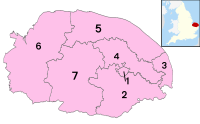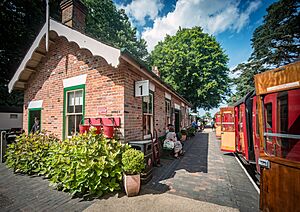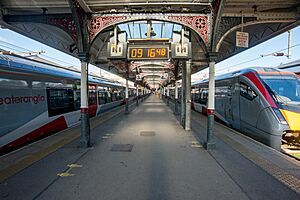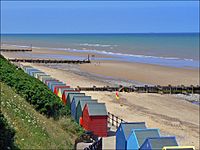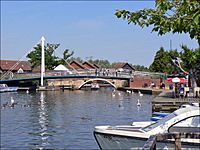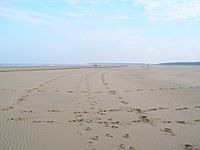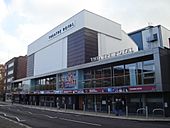Norfolk facts for kids
Quick facts for kids
Norfolk
|
|||||||||||||||||||||||||||||||||||||||||||||||||||||
|---|---|---|---|---|---|---|---|---|---|---|---|---|---|---|---|---|---|---|---|---|---|---|---|---|---|---|---|---|---|---|---|---|---|---|---|---|---|---|---|---|---|---|---|---|---|---|---|---|---|---|---|---|---|
|
Clockwise from top: Cley next the Sea and its windmill; Norwich Cathedral; and the Guildhall, King's Lynn, showing Norfolk flint flushwork
|
|||||||||||||||||||||||||||||||||||||||||||||||||||||
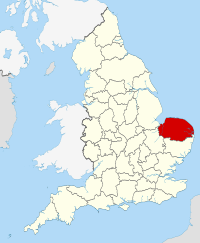 |
|||||||||||||||||||||||||||||||||||||||||||||||||||||
| Sovereign state | United Kingdom | ||||||||||||||||||||||||||||||||||||||||||||||||||||
| Constituent country | England | ||||||||||||||||||||||||||||||||||||||||||||||||||||
| Region | East of England | ||||||||||||||||||||||||||||||||||||||||||||||||||||
| Established | Pre Roman Celt period | ||||||||||||||||||||||||||||||||||||||||||||||||||||
| Time zone | UTC±00:00 (Greenwich Mean Time) | ||||||||||||||||||||||||||||||||||||||||||||||||||||
| • Summer (DST) | UTC+01:00 (British Summer Time) | ||||||||||||||||||||||||||||||||||||||||||||||||||||
| Members of Parliament | 9 MPs | ||||||||||||||||||||||||||||||||||||||||||||||||||||
| Police | Norfolk Constabulary | ||||||||||||||||||||||||||||||||||||||||||||||||||||
|
|||||||||||||||||||||||||||||||||||||||||||||||||||||
Norfolk (/ˈnɔːrfək/ NOR-fək) is a county in the East of England. It borders Lincolnshire and The Wash to the north-west. The North Sea is to its north and east. Cambridgeshire is to the west, and Suffolk is to the south. The biggest city in Norfolk is Norwich.
Norfolk covers about 5,372 square kilometers (2,074 square miles). Around 859,400 people live here. It is mostly a rural area with few big towns. After Norwich, the largest towns are King's Lynn, Great Yarmouth, and Thetford. Norfolk is divided into seven local government areas.
The western part of Norfolk is flat and was once a marsh. The middle of the county has gentle hills. Its northern coast is a beautiful natural area. Part of Thetford Forest is in the south. In the east, you'll find the Broads. This is a network of rivers and lakes that also goes into Suffolk. The Broads area is protected like a national park. Norfolk's coast can wear away easily because of its clay and chalk ground.
People have lived in Norfolk since prehistoric times. The Iceni tribe lived here during the Roman era. Their leader, Boudica, led a big revolt in AD 60. Later, the Angles settled in the 5th century. This area became part of the Kingdom of East Anglia. In the Middle Ages, Norfolk was very rich. It was important for the wool trade. This wealth helped build many large churches. In 1549, Kett's Rebellion happened here. People protested against land being fenced off. Norfolk did not become very industrial during the Industrial Revolution. Norwich lost its place as one of England's biggest cities. Today, Norfolk's economy mainly relies on farming and tourism.
Contents
Norfolk's Past: A Journey Through Time
Norfolk has been settled since before Roman times. Early camps were found on higher land in the west. People could dig for flint there. The Iceni tribe lived in the county from about 100 BC to 100 AD. They fought against the Roman invasion in AD 47. They rebelled again in AD 60, led by their queen, Boudica. After this second rebellion was stopped, the Romans took control. During the Roman era, roads and ports were built. Farming became common across the county.
Early Settlers and Kingdoms
Being on the east coast, Norfolk was open to attacks from Scandinavia and Northern Europe. Forts were built to defend against the Angles and Saxons. By the 5th century, the Angles had taken control. They later became known as the "north folk" and "south folk." This is how "Norfolk" and "Suffolk" got their names. Norfolk and Suffolk became the kingdom of East Anglia. This kingdom later joined with Mercia and then Wessex. Many place names ending in "-ton" and "-ham" show the influence of these early English settlers.
In the 9th century, the region was attacked by Danes. They killed King Edmund the Martyr. Place names ending in "-by" and "-thorpe" show Danish influence. Before the Norman Conquest, wetlands in the east were turned into farmland. More settlements grew in these areas. Many people moved to East Anglia. By the time of the Domesday Book survey, it was one of the most populated parts of Britain.
Medieval Prosperity and Challenges
During the Middle Ages, Norfolk grew crops and had a strong wool industry. The county's wealth can be seen in its many medieval churches. Out of over a thousand original churches, 659 still stand today. This is more than in the rest of Great Britain combined. The economy started to decline by the time of the Black Death in 1349. This plague greatly reduced the population. By the 16th century, Norwich was England's second-largest city. However, over a third of its people died in the plague of 1579. The Great Plague in 1665 also killed about a third of the population.
During the English Civil War, Norfolk mostly supported Parliament. The region's economy and farming declined a bit. The Industrial Revolution did not bring much industry to Norfolk. Only Norwich saw some industrial growth, and it was late to get railway connections.
Norfolk in the 20th Century
In the 20th century, aviation became important in Norfolk. Airfields first developed during the First World War. There was a huge increase during the Second World War. This was due to the growth of the Royal Air Force and the arrival of the American USAAF 8th Air Force. They operated from many Norfolk airfields. During the Second World War, farming became much more intense. It has stayed that way since, with large fields for growing cereals and oilseed rape.
Norfolk's Economy and Jobs
Norfolk's economy is an important part of England's overall economy. In 2017, the average hourly pay was £12.17. The average weekly pay was £496.80. About 74.2% of people aged 16 to 64 had jobs.
Key Industries and Businesses
Tourism is a very important industry in Norfolk. In 2017, it added £3.25 billion to the economy each year. It also supported about 65,000 jobs. This makes tourism the fifth most important type of employment in Norfolk. The money from visitors has grown by over £500 million since 2012.
Other important business areas include energy (oil, gas, and renewable energy). Advanced engineering and manufacturing are also key. Food and farming are big parts of the economy too. Much of Norfolk's flat and fertile land is used for growing crops. Over 20% of jobs in the county are in farming and food industries.
Well-known companies in Norfolk include Aviva (an insurance company), Colman's (known for mustard), Lotus Cars (car manufacturer), and Bernard Matthews Farms (food producer). The Construction Industry Training Board is also based here.
Local business leaders are working to create more jobs across Norfolk and Suffolk. They have set up an "enterprise zone" to help energy businesses grow. They also want the two counties to be a center for green energy products and services.
Managing the Coastline
Norfolk's low-lying land and soft cliffs make it vulnerable to the sea. The cliffs are made of chalk and clay, which wear away easily. A major flood happened in the North Sea flood of 1953. The British Environment Agency manages the coast to protect areas like the Broads from sea flooding. Plans are in place to protect the North Norfolk coastline for at least 50 more years. However, rising sea levels might mean changes to how sea defenses are managed in the future.
Media and Communication
Television and Radio
Norfolk gets its TV from BBC East and ITV Anglia, both based in Norwich. Some parts of north-western Norfolk, like King's Lynn, get TV from BBC Yorkshire and Lincolnshire and ITV Yorkshire.
For radio, BBC Radio Norfolk covers the county. Commercial stations include Heart East, Greatest Hits Radio East, Amber Radio, and Kiss. There are also local community radio stations like Future Radio in Norwich and Harbour Radio for Great Yarmouth.
Local Newspapers
Norfolk has several local newspapers:
- Eastern Daily Press (covers the whole county)
- Norwich Evening News (for Norwich)
- Great Yarmouth Mercury (for Great Yarmouth)
- Lynn News (for King's Lynn & Hunstanton)
- Diss Express (for Diss)
- North Norfolk News (for North Norfolk)
Learning and Education
Schools in Norfolk
Norfolk has a system of state schools managed by Norfolk County Council. Most secondary schools teach students from age 11 to 16 or 18. Since 2011, some schools have become "academies" or "free schools." These are still publicly funded but are not managed by the county council.
In many rural areas, there are no nearby sixth forms (for ages 16-18). So, larger towns have sixth form colleges. Norfolk also has twelve private schools. These include Gresham's School in Holt and Thetford Grammar School in Thetford. Thetford Grammar is one of Britain's oldest schools. Wymondham College is the UK's largest state boarding school.
Higher Education
The University of East Anglia is located near Norwich. Norwich University of the Arts is in the city center.
City College Norwich and the College of West Anglia offer courses in Norwich and King's Lynn. Easton & Otley College provides agriculture-based courses. The University of Suffolk also offers higher education courses in Norfolk.
Emergency Services
Norfolk is served by several emergency services:
- Norfolk Fire and Rescue Service
- East of England Ambulance Service
- East Anglian Air Ambulance
- Norfolk Constabulary (Police)
- British Transport Police
- HM Coastguard
Towns and Villages
Norfolk's main town and only city is Norwich. It was one of England's largest settlements during the Norman period. Norwich is home to the University of East Anglia. It is the county's main business and culture hub. Other important towns include the port of King's Lynn and the seaside town of Great Yarmouth. Great Yarmouth is also a gateway to the Broads.
Based on the 2011 Census, Norfolk's largest population centers are:
- Norwich (213,166 people)
- Great Yarmouth (63,434)
- King's Lynn (46,093)
- Thetford (24,883)
- Dereham (20,651)
- Wymondham (13,587)
- North Walsham (12,463)
- Attleborough (10,549)
- Downham Market (9,994)
- Diss (9,829)
- Fakenham (8,285)
- Cromer (7,749)
- Sheringham (7,367)
- Swaffham (7,258)
Smaller market towns include Aylsham, Harleston, and Holt. Much of Norfolk is still rural. It is thought that about 200 settlements have been lost since medieval times. These were lost due to coastal erosion, changes in farming, or becoming empty.
Getting Around Norfolk
Roads and Railways
Norfolk is one of the few counties in England without a motorway. The A11 connects Norfolk to Cambridge and London. From the west, the A47 links to the East Midlands and Birmingham. The A17 connects to the East Midlands via Lincolnshire. Both the A47 and A17 meet at King's Lynn. The A10 also starts in King's Lynn, linking West Norfolk to London.
Two main railway lines connect Norfolk to London. The Great Eastern Main Line runs from Norwich to Liverpool Street in London. The Fen line offers services between King's Lynn and King's Cross. The Breckland line connects Norwich and Thetford to places like Peterborough, Nottingham, and Manchester.
Air Travel
Norwich International Airport has flights to various European places. It also connects to Amsterdam, which offers flights worldwide.
Norfolk's Unique Voice and Nickname
The Norfolk dialect is sometimes called "Broad Norfolk." However, many of its old words and phrases have faded away. This is due to radio, TV, and people moving in from other parts of the country. So, Norfolk speech is now more of an accent than a full dialect. But it still has a special way of using grammar.
People from Norfolk are sometimes called "Norfolk Dumplings." This name comes from the flour dumplings that were a traditional part of the local diet.
Fun Things to Do in Norfolk
Norfolk is a popular place for tourists. It has many great holiday attractions. There are several seaside resorts with beautiful beaches, like those at Great Yarmouth, Cromer, and Holkham. Norfolk is home to the Broads and other areas of amazing natural beauty. Many parts of the coast are bird sanctuaries and reserves. Some areas, like the Norfolk Coast AONB, are protected like national parks.
-
Elm Hill in the historic city of Norwich -
The Norfolk Coast in the little village of Mundesley near Cromer -
The beach at Holkham National Nature Reserve
The King's home, Sandringham House in Sandringham, is a popular place to visit all year. The coast and some rural areas are popular for people to buy holiday homes. The famous writer Arthur Conan Doyle got the idea for The Hound of the Baskervilles while on holiday in Cromer. He heard local stories about a mysterious hound called Black Shuck.
Amusement Parks and Zoos
Norfolk has several fun amusement parks and zoos:
- Thrigby Hall near Great Yarmouth has a zoo with tigers, primates, and crocodiles.
- Holkham Hall is a grand 18th-century house. It has a 3,000-acre deer park, a woodland play area, and a farming exhibit.
- Roarr! Dinosaur Adventure in Lenwade is a dinosaur-themed park. It has a dinosaur trail, indoor play, and a high ropes course.
- Great Yarmouth Pleasure Beach is a free-entry theme park with over twenty rides, including "white knuckle" rides.
- BeWILDerwood is an adventure park in the Norfolk Broads. It is featured in the children's book A Boggle at BeWILDerwood.
- Britannia Pier in Great Yarmouth has rides like a ghost train and the famous Britannia Pier Theatre.
- Banham Zoo is set in 35 acres of parkland. It has big cats, birds of prey, and other animals. Over 200,000 people visit each year.
- Pensthorpe Nature Reserve near Fakenham is a nature reserve with many birds and animals. It was once home to the BBC's Springwatch show.
- The Sea Life Centre in Great Yarmouth is one of the biggest in the country. It has a tropical shark display with a walk-through underwater tunnel.
- The Sea Life Sanctuary in Hunstanton rescues and helps sick or injured sea creatures found in The Wash and North Sea.
Theatres for Shows
Norfolk has many theatres for plays, music, and shows:
- The Pavilion Theatre in Cromer is on the end of Cromer Pier. It is known for its 'end-of-the-pier' show, the Seaside Special.
- The Britannia Pier Theatre in Great Yarmouth hosts popular comedy acts. It has 1,200 seats, making it one of Norfolk's largest.
- The Theatre Royal in Norwich has been on its site for nearly 250 years. It is the largest theatre in the city with 1,300 seats. It hosts musicals, dance, drama, and comedy.
- The Norwich Playhouse hosts theatre, comedy, and music. It can seat 300 people.
- The Maddermarket Theatre in Norwich opened in 1921. It was the first permanent recreation of an Elizabethan theatre.
- The Norwich Puppet Theatre is unique in the region. It is dedicated to puppetry and has a 185-seat auditorium.
- The Garage studio theatre in Norwich can seat up to 110 people.
- The Platform Theatre in Norwich is at City College Norwich. It has a large stage and seats about 200 people.
- The Sewell Barn Theatre in Norwich is the smallest theatre in the city, seating 100.
- The Norwich Arts Centre in Norwich opened in 1977 and has a capacity of 290.
- The Princess Theatre in Hunstanton overlooks the Wash. It is a 472-seat venue with a variety of shows.
- Sheringham Little Theatre seats 180 and shows plays, musicals, music, and films.
- The Gorleston Pavilion is an Edwardian building with 300 seats. It stages plays, pantomimes, and concerts.
People of Norfolk
Norfolk has been home to many famous people throughout history.
Notable People From Norfolk
- George VI: King of the United Kingdom, born and died on the Sandringham Estate.
- Boudica: Queen of the Iceni tribe, who led a revolt against the Roman Army.
- Horatio, Lord Nelson: A famous British Admiral and hero of the Battle of Trafalgar.
- Diana, Princess of Wales: First wife of Prince Charles, born and grew up near the Sandringham estate.
- Stephen Fry: Actor, comedian, and writer, who grew up in Booton.
- Olivia Colman: Award-winning actress, born and educated in Norfolk.
- Sir James Dyson: Inventor and entrepreneur, born in Cromer.
- Thomas Paine: A famous philosopher, born in Thetford.
- Julian of Norwich: A medieval mystic who lived much of her life in Norwich.
- Elizabeth Fry: A 19th-century Quaker who worked to reform prisons.
- Sam Claflin: Actor, grew up in Norwich.
- Lauren Hemp: Footballer for England, part of the team that won the UEFA Women's Euro 2022.
- George Russell (racing driver): Formula 1 driver, born in King's Lynn.
People Connected to Norfolk
Many other well-known people have lived in or contributed to Norfolk:
- Bill Bryson: A popular writer, has lived in the county since 2003.
- Adam Buxton: Comedian, moved to Norfolk in 2008.
- John Major: British Prime Minister from 1990 to 1997, has a holiday home in Weybourne.
- Alan Partridge: A fictional media personality played by Steve Coogan. His film Alan Partridge: Alpha Papa was set and filmed in Norwich.
- Pocahontas: A Native American woman who lived at Heacham Hall for a time.
- Delia Smith: A famous cookery writer and a major shareholder of Norwich City Football Club.
Images for kids
-
River Wensum, Norwich
-
Norwich Cathedral: spire and south transept
See also
 In Spanish: Norfolk para niños
In Spanish: Norfolk para niños





